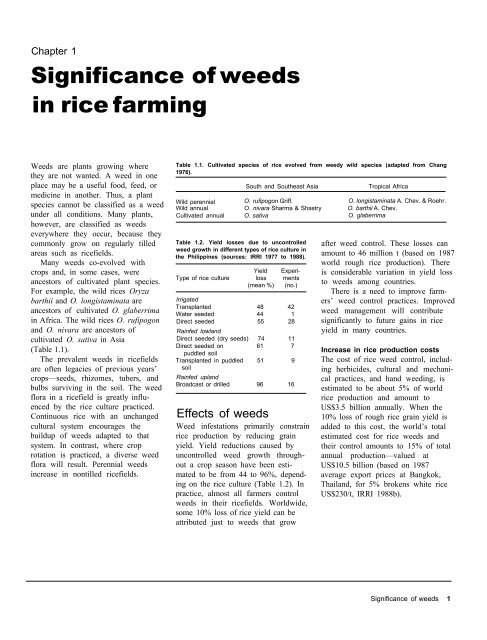A handbbok on Weed Control in Rice.pdf
A handbbok on Weed Control in Rice.pdf
A handbbok on Weed Control in Rice.pdf
You also want an ePaper? Increase the reach of your titles
YUMPU automatically turns print PDFs into web optimized ePapers that Google loves.
Chapter 1<br />
Significance of weeds<br />
<strong>in</strong> rice farm<strong>in</strong>g<br />
<strong>Weed</strong>s are plants grow<strong>in</strong>g where<br />
they are not wanted. A weed <strong>in</strong> <strong>on</strong>e<br />
place may be a useful food, feed, or<br />
medic<strong>in</strong>e <strong>in</strong> another. Thus, a plant<br />
species cannot be classified as a weed<br />
under all c<strong>on</strong>diti<strong>on</strong>s. Many plants,<br />
however, are classified as weeds<br />
everywhere they occur, because they<br />
comm<strong>on</strong>ly grow <strong>on</strong> regularly tilled<br />
areas such as ricefields.<br />
Many weeds co-evolved with<br />
crops and, <strong>in</strong> some cases, were<br />
ancestors of cultivated plant species.<br />
For example, the wild rices Oryza<br />
barthii and O. l<strong>on</strong>gistam<strong>in</strong>ata are<br />
ancestors of cultivated O. glaberrima<br />
<strong>in</strong> Africa. The wild rices O. rufipog<strong>on</strong><br />
and O. nivara are ancestors of<br />
cultivated O. sativa <strong>in</strong> Asia<br />
(Table 1.1).<br />
The prevalent weeds <strong>in</strong> ricefields<br />
are often legacies of previous years’<br />
crops—seeds, rhizomes, tubers, and<br />
bulbs surviv<strong>in</strong>g <strong>in</strong> the soil. The weed<br />
flora <strong>in</strong> a ricefield is greatly <strong>in</strong>flu-<br />
enced by the rice culture practiced.<br />
C<strong>on</strong>t<strong>in</strong>uous rice with an unchanged<br />
cultural system encourages the<br />
buildup of weeds adapted to that<br />
system. In c<strong>on</strong>trast, where crop<br />
rotati<strong>on</strong> is practiced, a diverse weed<br />
flora will result. Perennial weeds<br />
<strong>in</strong>crease <strong>in</strong> n<strong>on</strong>tilled ricefields.<br />
Table 1.1. Cultivated species of rice evolved from weedy wild species (adapted from Chang<br />
1976).<br />
South and Southeast Asia Tropical Africa<br />
Wild perennial O. rufipog<strong>on</strong> Griff.<br />
Wild annual O. nivara Sharma & Shastry<br />
Cultivated annual O. sativa<br />
Table 1.2. Yield losses due to unc<strong>on</strong>trolled<br />
weed growth <strong>in</strong> different types of rice culture <strong>in</strong><br />
the Philipp<strong>in</strong>es (sources: IRRI 1977 to 1988).<br />
Yield Experi-<br />
Type of rice culture loss ments<br />
(mean %) (no.)<br />
lrrigated<br />
Transplanted 48 42<br />
Water seeded 44 1<br />
Direct seeded<br />
Ra<strong>in</strong>fed lowland<br />
55 28<br />
Direct seeded (dry seeds) 74 11<br />
Direct seeded <strong>on</strong><br />
puddled soil<br />
61 7<br />
Transplanted <strong>in</strong> puddled<br />
soil<br />
Ra<strong>in</strong>fed upland<br />
51 9<br />
Broadcast or drilled 96 16<br />
Effects of weeds<br />
<strong>Weed</strong> <strong>in</strong>festati<strong>on</strong>s primarily c<strong>on</strong>stra<strong>in</strong><br />
rice producti<strong>on</strong> by reduc<strong>in</strong>g gra<strong>in</strong><br />
yield. Yield reducti<strong>on</strong>s caused by<br />
unc<strong>on</strong>trolled weed growth through-<br />
out a crop seas<strong>on</strong> have been esti-<br />
mated to be from 44 to 96%, depend-<br />
<strong>in</strong>g <strong>on</strong> the rice culture (Table 1.2). In<br />
practice, almost all farmers c<strong>on</strong>trol<br />
weeds <strong>in</strong> their ricefields. Worldwide,<br />
some 10% loss of rice yield can be<br />
attributed just to weeds that grow<br />
O. l<strong>on</strong>gistam<strong>in</strong>ata A. Chev. & Roehr.<br />
O. barthii A. Chev.<br />
O. glaberrima<br />
after weed c<strong>on</strong>trol. These losses can<br />
amount to 46 milli<strong>on</strong> t (based <strong>on</strong> 1987<br />
world rough rice producti<strong>on</strong>). There<br />
is c<strong>on</strong>siderable variati<strong>on</strong> <strong>in</strong> yield loss<br />
to weeds am<strong>on</strong>g countries.<br />
There is a need to improve farm-<br />
ers’ weed c<strong>on</strong>trol practices. Improved<br />
weed management will c<strong>on</strong>tribute<br />
significantly to future ga<strong>in</strong>s <strong>in</strong> rice<br />
yield <strong>in</strong> many countries.<br />
Increase <strong>in</strong> rice producti<strong>on</strong> costs<br />
The cost of rice weed c<strong>on</strong>trol, <strong>in</strong>clud-<br />
<strong>in</strong>g herbicides, cultural and mechani-<br />
cal practices, and hand weed<strong>in</strong>g, is<br />
estimated to be about 5% of world<br />
rice producti<strong>on</strong> and amount to<br />
US$3.5 billi<strong>on</strong> annually. When the<br />
10% loss of rough rice gra<strong>in</strong> yield is<br />
added to this cost, the world’s total<br />
estimated cost for rice weeds and<br />
their c<strong>on</strong>trol amounts to 15% of total<br />
annual producti<strong>on</strong>—valued at<br />
US$10.5 billi<strong>on</strong> (based <strong>on</strong> 1987<br />
average export prices at Bangkok,<br />
Thailand, for 5% brokens white rice<br />
US$230/t, IRRI 1988b).<br />
Significance of weeds 1











